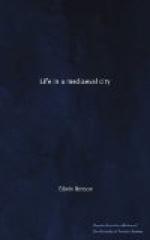Of mediaeval punishments the most obvious were the stocks, a contemporary picture of which is to be seen in one of the stained-glass windows of All Saints’, North Street. Examples of stocks survive in the churchyards of Holy Trinity, Micklegate, and St. Lawrence’s. They were near the entrance to the churchyard and commanded full public attention. The petty offender, condemned to spend so many hours in the public gaze and subject to whatever treatment the public chose to inflict on him, sat on the ground or on a low seat, while his feet were secured at the ankles by two vertical boards. The upper was raised for the insertion of the ankles in the specially cut-out half-round holes in each board, so that when the boards were touching and in the same vertical plane, the ankles were completely surrounded by wood.
To its political importance York owed the ghastly exhibition of heads and odd quarters of traitors and others who had gained punishment of national importance, which usually consisted of “hanging, drawing and quartering,” when the quarters and the head were sent to London and the principal towns of the kingdom to be exhibited on gateways, towers, and bridges. This practice served to provide the public with convincing proof that a traitor was actually dead, and was very necessary in an age when Rumour, “stuffing the ears of men with false reports” held sway over “the blunt monster with uncounted heads, the still discordant wavering multitude.” Micklegate Bar was so used. In Shakespeare’s Henry VI. Queen Margaret makes, with reference to the Duke of York, this bitter play of words:—
“Off with his head and
set it on York gates;
So York may overlook the town
of York.”
One very interesting practice in connection with the mediaeval system of law and policing was the use of the right of sanctuary. The monasteries, the Minster, and all churches had this right of giving a sacrosanct safety to criminals and others flying from their pursuers, whether officers of the law or the general mob, whose right, be it noted, it was to join in the chase after offenders (the “hue and cry”) and help to arrest them. Provided the pursued reached the prescribed area, which, in some cases, as at the nationally famous sanctuary of St. John of Beverley, prevailed for some distance from the church itself, he was safe from his pursuers. Hexham Abbey and Beverley Minster still exhibit their sanctuary chairs or frith-stools. In the north door of Durham Cathedral there is an ancient, massive knocker, the rapper, of the form of a ring, being held in the mouth of a grotesque head. The frith-stool, to which the seeker went at once, stood near the high altar at which he made his declarations on oath. His case was carefully investigated and often sanctuary-seekers were allowed to exile themselves from the kingdom. The coroner was the public officer of inquiry. The Church took every care that the crime of breaking the sanctuary so granted was regarded not at all lightly. The right of sanctuary, after being changed to apply to certain towns only—among them York—continued till it was ended by law in the reign of James I.




